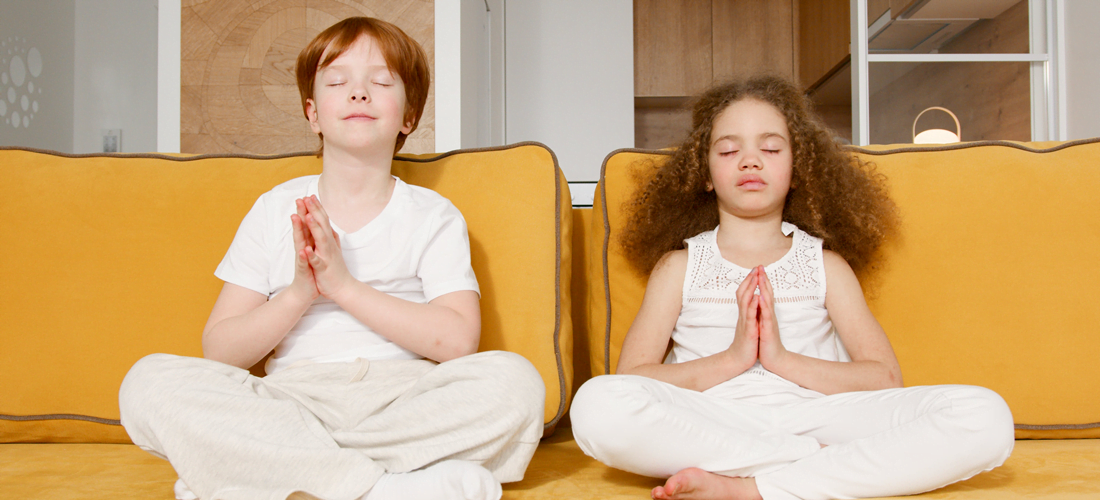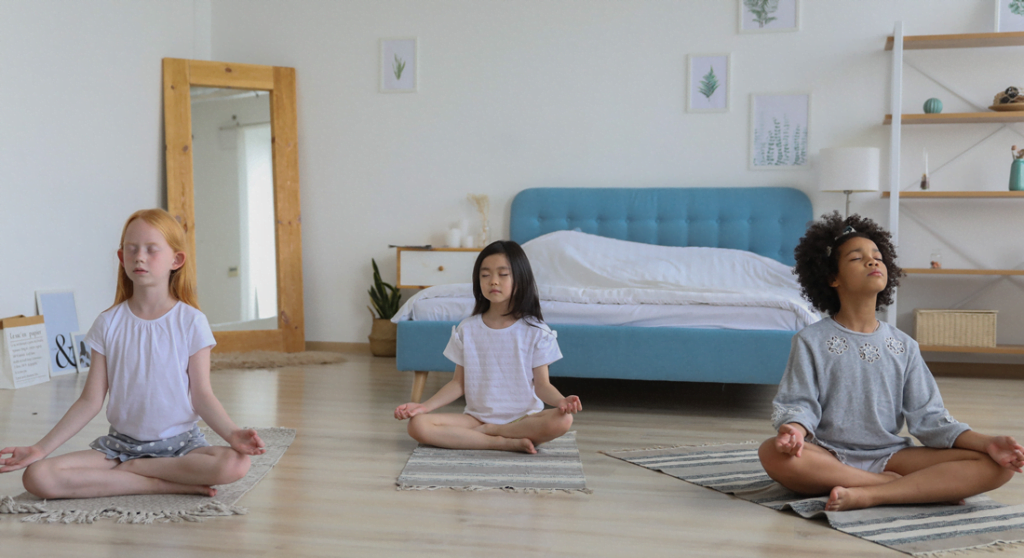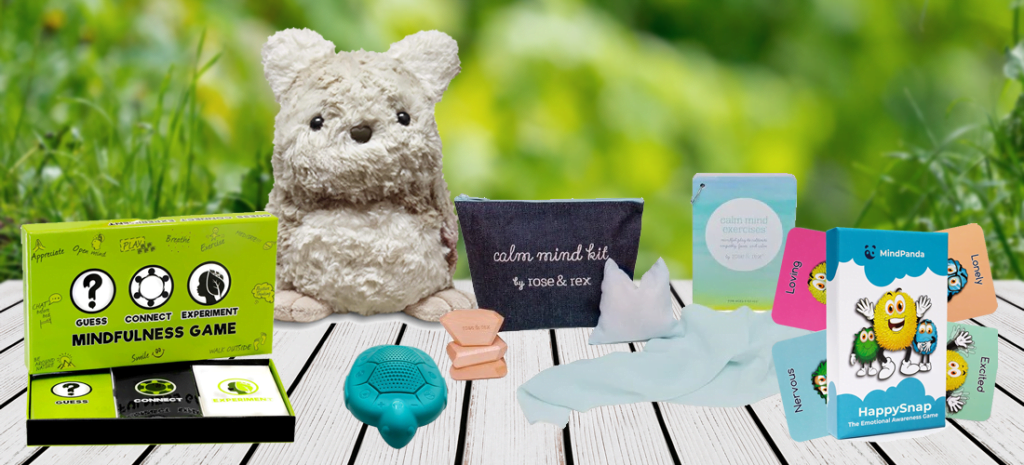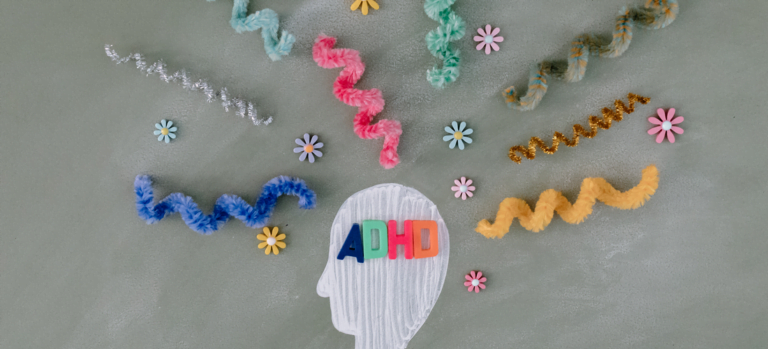Meditation isn’t just for adults anymore! With the hustle and bustle of modern life, even our kids can benefit from a little mindfulness. Welcome to our guide on meditation for kids, where we’ll explore the ins and outs of introducing these calming techniques to the younger generation. Whether your child is a bouncing toddler or a sassy teenager, we’ve got some tips and tricks that can help them find serenity amongst the chaos.
Mindfulness plays a crucial role in a child’s developmental journey. By teaching kids how to become aware of their thoughts and emotions in a non-judgmental way, we can equip them with a powerful tool for managing stress. It fosters self-control, improves focus, and helps children become more patient and empathetic. In a world that is increasingly fast-paced, mindfulness can offer kids a peaceful haven, giving them the space to understand and regulate their inner world better.
What is Meditation for Kids?
Meditation for kids, in essence, is a set of easy, fun, and accessible techniques designed to help children cultivate self-awareness, focus, and tranquility. Unlike the adult version which may involve long periods of silence and stillness, kids’ meditation involves engaging activities tailored to their age and interests.
This can range from mindful coloring to guided visualizations, promoting a sense of calm and helping them navigate their emotions more effectively. As simple as it sounds, the impact is profound, providing kids a solid foundation for emotional well-being and cognitive development.
Benefits of Meditation for Kids
- Improved Focus and Concentration: Just like adults, children can have scattered minds too. Meditation can help them learn how to focus their attention and build better concentration, which can prove beneficial in their academics and other day-to-day activities.
- Stress Relief: Kids can feel stress from various factors like schoolwork, peer pressure, or family issues. Regular meditation practice can enable them to handle stress more effectively and maintain their emotional well-being.
- Enhanced Emotional Regulation: Through meditation, kids can become more aware of their emotions. This awareness can help them understand and manage their feelings better, leading to improved emotional regulation.
- Better Sleep: A calm mind promotes better sleep. By practicing meditation, kids can learn how to relax their minds, promoting healthier sleep patterns.
- Increased Self-Awareness and Self-Esteem: Through meditation, kids can gain a better understanding of themselves, which can boost their confidence and self-esteem.
- Develops Patience and Tolerance: Regular meditation can help children develop patience, learn how to delay gratification, and become more tolerant of others.
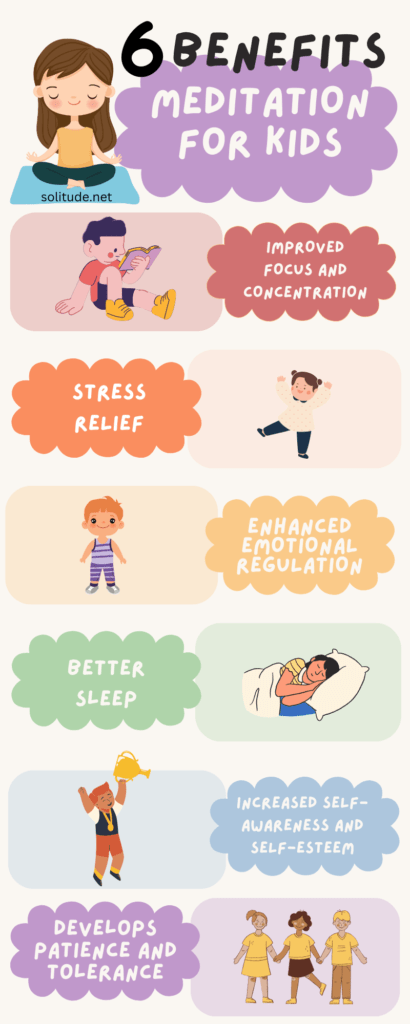
Incorporating meditation into a child’s daily routine can be a game-changer. These benefits go beyond the immediate relaxation we get from deep breathing. Over time, children who meditate can develop robust coping mechanisms that will serve them well throughout their lives.
Different Forms of Meditation Suitable for Kids
- Mindfulness Meditation: This form of meditation involves focusing on the present moment. It encourages kids to experience their environment, thoughts, and feelings without passing any judgment. Mindfulness can be practiced during daily activities like eating, walking, or even while sitting quietly.
- Concentration Meditation: Concentration meditation involves focusing on a single point. This could be following the breath, repeating a single word or mantra, listening to a repetitive gong, or staring at a candle flame. As children practice this form of meditation, their ability to focus enhances over time.
- Loving-Kindness Meditation: Also known as Metta meditation, this form encourages children to send out feelings of love and goodwill towards the world. It starts with loving oneself and gradually extends to others, fostering empathy and compassion in children.
- Body Scan or Progressive Relaxation: This form of meditation encourages children to scan their bodies for any tension. They are taught to notice what each part of their body feels like and where they might be holding stress. This can be particularly useful for children who have trouble falling asleep.
- Guided Visualization: Guided visualization involves painting a peaceful picture or narrating a calming story that kids can imagine. It’s like using the power of their mind to transport them to a peaceful place. This form of meditation can be particularly engaging for children with active imaginations.
Each form of meditation has its unique benefits. It’s crucial to introduce these methods to children and let them choose the one they resonate most with. The key is to make the practice consistent and enjoyable.
Meditation for Kids: Setting the Stage
Creating a Calm and Inviting Meditation Space
Creating a calm and inviting meditation space for children is essential in fostering an environment conducive to mindfulness. Start by choosing a quiet spot in your home, away from the usual hustle and bustle. The place should offer a feeling of safety and serenity, allowing the child to easily slip into a meditation state.
Next, personalize the space to suit your child’s tastes. Children respond well to visual prompts, so you might consider adding calming colors, nature-inspired art, or soft lighting to the meditation area. Pillows or comfortable mats can provide seating that encourages relaxation.
Aromatherapy with gentle, kid-friendly scents like lavender or chamomile can also aid in setting a serene atmosphere. Additionally, having a dedicated box or basket within the space where meditation tools like chimes, visual timers, or stress balls are stored, can help children take ownership of their meditation practice.
Choosing Appropriate Duration and Timing for Kids’ Sessions
Choosing the appropriate duration and timing for kids’ meditation sessions is also a critical element in their mindfulness journey. It’s important to remember that a child’s attention span may be shorter than that of an adult, so shorter, more frequent sessions could be more beneficial initially. Younger children might start with just a few minutes of meditation, gradually increasing the duration as they become more comfortable with the practice. For older kids, starting with 10 minutes and working up to 20 or 30 minutes per session could be more suitable.
Timing is equally crucial. Attempting to have kids meditate when they are overly energetic or restless can lead to frustration. Instead, try incorporating meditation sessions during calmer periods of the day, such as after a bath, before bedtime, or even first thing in the morning. Over time, your child will likely start to recognize the signs of when they need to meditate, tuning in to their own needs and establishing a healthy, self-directed mindfulness practice.
Kid-Friendly Meditation Techniques
Guided imagery and visualization
Guided imagery and visualization is a highly effective meditation technique for children. It involves using mental images to promote relaxation and mindfulness. Children are naturally imaginative, making this approach particularly suitable for them.
During these sessions, the child is gently led through a story or scene, such as imagining they are floating on a cloud or lying on a warm beach. The guide will describe the environment in detail, engaging multiple senses, and promoting a deep sense of calm and relaxation.
This process not only enhances creative thinking and imagination but also helps children manage stress and anxiety by providing them with tools to visualize peaceful scenarios when they encounter difficult situations.
Breathing Exercises and Mindful Breathing
Breathing exercises and mindful breathing are fundamental techniques that can introduce kids to the practice of meditation. These exercises are centered around focusing on one’s breath, enabling children to connect with the present moment and cultivate a sense of inner tranquility.
A simple exercise to start with involves instructing the child to take a deep breath in, hold it for a few seconds, and then exhale slowly. This can be visualized as smelling a flower and then blowing out a candle. By repeating this process, children can cultivate an enhanced awareness of their own breath, helping them to feel grounded and relaxed.
More advanced exercises may include “square breathing” (inhale, hold, exhale, hold) or “belly breathing”, where the child places a hand on their stomach to physically feel the rise and fall of their breath. Both these exercises can be particularly effective in helping children manage feelings of stress or anxiety, promoting a sense of calm and mindfulness.
Mindfulness Games and Activities
Mindfulness games and activities are a playful and interactive way to introduce children to the practice of meditation. These games encompass a variety of exercises that are designed not only to entertain but also to enhance concentration, encourage self-awareness, and promote a sense of calm.
An example of such a game could be “The Listening Game”, where children close their eyes and identify as many sounds as they can within a set period of time. This game helps in sharpening their auditory perception and brings them to the present moment.
Another popular mindfulness activity is “Mindful Coloring”, where children are encouraged to color in a detailed pattern or picture while focusing on their sensations and thoughts. This activity can bring a sense of calm and relaxation, providing a meditative effect.
Lastly, “The Heartbeat Game” involves children doing a short burst of physical exercise to raise their heartbeat (like jumping jacks or running on the spot), then sitting quietly and putting a hand on their chest to feel their heartbeat slow down. This exercise not only promotes mindfulness but also provides a practical demonstration of the calming effect of meditation.
All these activities offer fun and age-appropriate ways for children to understand and practice mindfulness, making meditation an accessible and enjoyable practice for kids.
Gratitude Meditation
Gratitude meditation is another kid-friendly technique that can be both fun and beneficial. It involves focusing one’s thoughts on the people, things, and experiences for which they feel grateful. For kids, this can be as simple as thinking about their favorite toy, their best friend, or a fun family outing.
The exercise encourages children to reflect on the positive aspects of their lives, fostering a sense of contentment and appreciation. It also helps kids to realize that happiness can come from appreciating what they already have, rather than always wanting more.
This technique can be practiced by asking children to close their eyes and think about something they are thankful for, focusing on how that gratitude feels. Regular practice of gratitude meditation can help children develop a positive mindset, leading to increased happiness, improved relationships, and better physical health. Overall, it’s a great way to introduce kids to the benefits of meditation.
Teaching Kids to Meditate
Explaining Meditation to Children in a Simple Way
When explaining meditation to children, several strategies can be useful and easily understood.
- Relating to everyday experiences: Children may find it easier to understand meditation if it’s related to everyday experiences or activities they are already familiar with. For instance, you can liken meditation to being like a “pause button” on their favorite video game, helping them to take a break and refresh.
- Using simple language: Avoid using complex terms or jargon that might confuse children. Instead, describe meditation as a “quiet time” or a “peaceful moment” where they can relax and calm their minds.
- Storytelling: Kids love stories. Incorporating a narrative into the explanation can make it more appealing and engaging. For example, you could tell a story about a busy bee that learned to take quiet moments and noticed how much better it felt.
- Guided Imagery: Use guided imagery to explain meditation. Describe a calm and peaceful place and guide them to visualize being there. This can make the concept of meditation more tangible for them.
- Emphasizing the benefits: Highlight the benefits of meditation in a way that kids can understand. For example, explain that meditation can help them feel calmer when they’re upset, focus better on their homework, or even sleep better.
By employing these strategies, parents and educators can make the concept of meditation more accessible and relatable to children, helping them to embrace this beneficial practice.
Encouraging Curiosity and Exploration
Encouraging curiosity and exploration is a key aspect of teaching meditation to children. This approach allows children to discover the benefits of meditation at their own pace, fostering a sense of autonomy and ownership over their learning process.
By encouraging questions and open discussions, children are invited to express their feelings and thoughts about the practice, making meditation a more engaging and meaningful experience for them.
For example, you might encourage kids to explore how different breathing techniques affect their bodies and minds, or to experiment with various quiet activities during their meditation time – such as drawing, reading, or listening to calming music – and observe how they feel afterwards.
By promoting an exploratory mindset, children can better understand how meditation works and how it can be adapted to suit their individual needs and preferences. Importantly, this curiosity-driven approach can also help to instill a lifelong interest in meditation and self-care.
Being a Meditation Role Model
As with many aspects of life, children learn best by observing the behavior of those around them. When parents or educators incorporate meditation into their own daily routines, they serve as powerful role models for kids.
Seeing adults they respect and admire practice meditation sends a clear message about its importance and relevance. Additionally, when adults openly discuss their personal experiences with meditation – such as the challenges they faced when first starting out, the strategies they found helpful, or the positive changes they’ve noticed since they began meditating – they can inspire and motivate kids to give it a try.
For kids to truly embrace the practice of meditation, they need to see it as something that’s not only beneficial, but also doable and enjoyable. By being a meditation role model, you can provide the encouragement and guidance that children need as they begin their own meditation journey.
Overcoming Challenges
Dealing with Restlessness and Distractions
It’s completely normal for children to feel restless or get distracted, particularly when they’re first starting to meditate. Patience and understanding are key.
One effective method to manage restlessness is breaking down meditation sessions into smaller, manageable chunks. Instead of insisting on a prolonged session, start with just a few minutes and gradually increase the duration over time. This way, kids can get accustomed to the practice without feeling overwhelmed.
Distractions, on the other hand, can be managed by creating a calm and serene environment for meditation. Choose a quiet, comfortable spot free from excessive noise or visual stimulants. Encourage kids to turn off electronic devices or put them on silent mode during meditation time.
Additionally, guided meditations can keep a child’s focus anchored, making distractions less likely to occur. These guided sessions use imagery and narrative to engage children’s attention and foster tranquility.
The goal isn’t to eliminate all thoughts or distractions, but rather to gently bring the focus back each time the mind wanders. It’s all part of the learning process in meditation for kids.
Patience and Consistency in Meditation Practice
Patience and consistency are the cornerstones of effective meditation practice, especially for kids. Patience is integral because the benefits of meditation, such as increased focus, tranquility, and self-awareness, are often subtle and take time to manifest. It’s crucial to teach children that meditation is a journey, not a destination.
Consistency, on the other hand, is about making meditation a regular habit. As with any new skill, practice makes perfect. Regular, consistent practice helps children get familiar with the process, making it easier for them to slip into a meditative state over time. The cumulative effects of consistent meditation can lead to significant long-term benefits, such as improved emotional regulation, better concentration, and heightened self-esteem.
It’s worth noting that patience and consistency work hand in hand – having patience encourages consistency in practice, while consistent practice cultivates deeper patience. By promoting these values, we can help children reap the profound benefits of meditation in their daily lives.
Meditation for Specific Age Groups
Preschoolers and Young Children
When introducing meditation to preschoolers and young children, the approach should take into consideration their developmental stage and attention span. Here is a step-by-step guide:
Step 1: Create a Calm Environment
Begin by creating a quiet and comfortable space for the child. This could be a dedicated corner in their room, a spot in the living room, or even outside in nature. The key is to create a space free from distractions where the child feels safe and relaxed.
Step 2: Lead by Example
Children learn by observing adults. Practice your own meditation in their presence, this gives them a model to follow.
Step 3: Introduce Breathing Exercises
Start with simple breathing exercises. Instruct them to take a slow deep breath in, hold for a second, and then slowly breathe out. Use fun imagery, like imagining the breath is a wave coming in and going out, or blowing out imaginary candles.
Step 4: Use Guided Meditations
There are many guided meditations designed specifically for young children. These often incorporate stories and vivid imagery that captivate a child’s attention and guide them into a peaceful state of mind.
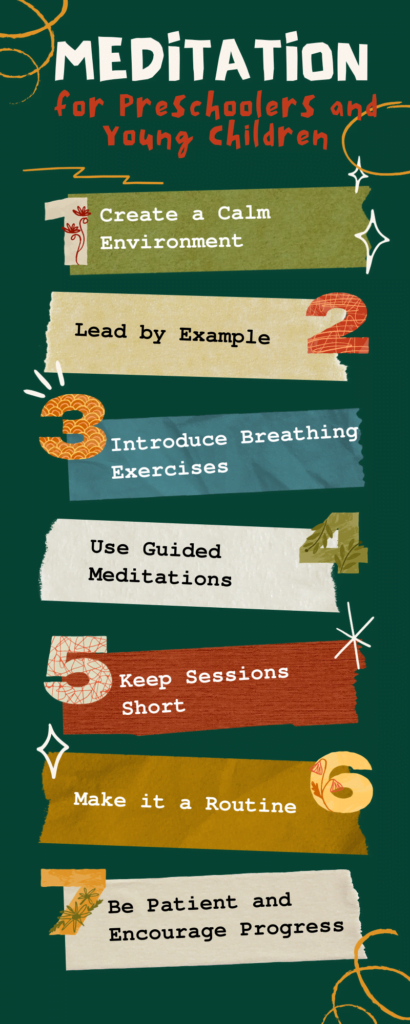
Step 5: Keep Sessions Short
Keep the meditation sessions short, between 1 to 3 minutes. As the child gets more comfortable with the practice, gradually increase the duration.
Step 6: Make it a Routine
Try to incorporate meditation into the child’s daily routine, such as after a nap or before bedtime. This regularity helps kids understand and value meditation as part of their daily life.
Step 7: Be Patient and Encourage Progress
Lastly, remember to be patient. Progress may be slow, but any steps towards mindfulness are valuable. Celebrate small achievements to encourage the child and sustain their interest in meditation.
Elementary School-Aged Children
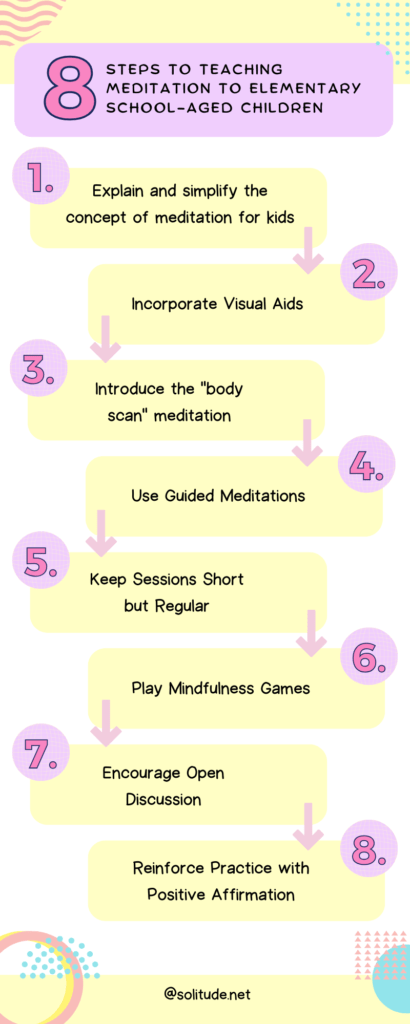
Step 1: Explanation and Simplification
Start by simplifying the concept of meditation for them. Explain it as taking a little time to calm our minds and focus. It’s like “taking a break” for our brain!
Step 2: Incorporate Visual Aids
Elementary school-aged children respond well to visual aids. Use props like a stuffed animal on their belly to demonstrate the rise and fall during deep breaths.
Step 3: Introduction to Body Scan
Introduce the “body scan” meditation. Guide them to focus their attention on different parts of their body, starting from the toes and moving up to the head. This helps them develop awareness of their body and its sensations.
Step 4: Use Guided Meditations
Use guided meditations tailored for their age group. These can be found in meditation apps or online. Choose ones with engaging narratives and vivid imagery.
Step 5: Keep Sessions Short but Regular
Keep the sessions short, around 5 minutes, but make them regular. Consistency is key in forming a new habit.
Step 6: Play Mindfulness Games
Play mindfulness games to make the practice fun. This could be a “listening game” where they close their eyes and identify sounds around them, or a “touch and tell” game where they describe the texture of different objects.
Step 7: Encourage Open Discussion
After the session, encourage them to share their experience. This validates their feelings and thoughts, and helps them relate meditation to their daily life.
Step 8: Reinforce Practice with Positive Affirmation
End the session with positive affirmation. Praise their efforts and progress, irrespective of how small they may be. This boosts their confidence and encourages them to continue the practice.
Adolescents and Teenagers
Step 1: Introduction to Meditation
For adolescents and teenagers, begin by explaining what meditation is and its benefits. Highlight how it can help manage stress, enhance focus, and improve emotional wellbeing. Use relatable examples, like acing a test or dealing with peer pressure.
Step 2: Start with Simple Breathing Exercises
Start with simple breathing exercises. Ask them to focus on their breathing, noticing the rise and fall of the chest. This helps to calm the mind and serves as an easy entry point to meditation.
Step 3: Teach Mindfulness
Introduce mindfulness by teaching them to be present and aware of their surroundings. This could be done through a “senses” exercise where they identify what they can see, hear, touch, smell, and taste in a given moment.
Step 4: Use Guided Meditations
Utilize guided meditations designed for their age group. There are many teenage-focused meditations online that cater to their unique challenges.
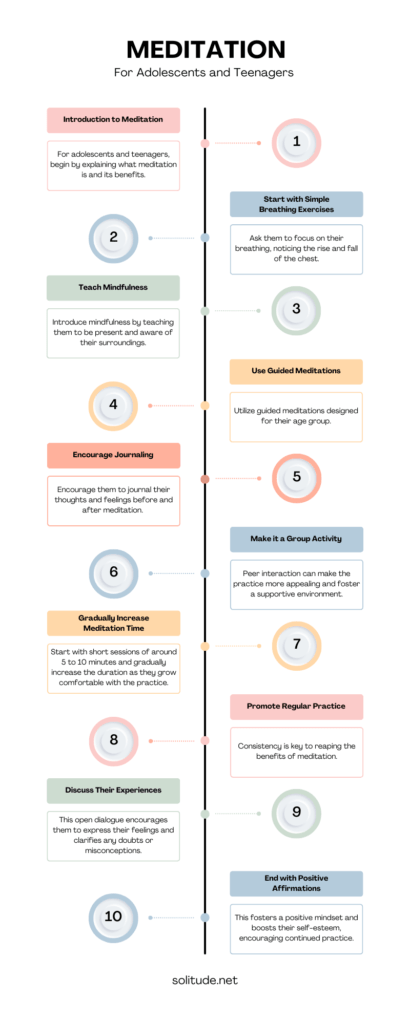
Step 5: Encourage Journaling
Encourage them to journal their thoughts and feelings before and after meditation. This promotes self-awareness and helps them recognize changes in their emotional state.
Step 6: Make it a Group Activity
Turn meditation into a group activity. Peer interaction can make the practice more appealing and foster a supportive environment.
Step 7: Gradually Increase Meditation Time
Start with short sessions of around 5 to 10 minutes and gradually increase the duration as they grow comfortable with the practice.
Step 8: Promote Regular Practice
Encourage regular practice. Consistency is key to reaping the benefits of meditation.
Step 9: Discuss Their Experiences
Discuss their experiences and thoughts on the meditation process. This open dialogue encourages them to express their feelings and clarifies any doubts or misconceptions.
Step 10: End with Positive Affirmations
End each session with positive affirmations. This fosters a positive mindset and boosts their self-esteem, encouraging continued practice.
Closing Thoughts on Meditation for Kids
The long-term benefits of introducing meditation to kids are manifold. Regular practice can foster increased focus, emotional stability, improved sleep patterns, and heightened self-awareness. These attributes can significantly enhance a child’s academic performance, social interactions, and overall well-being. In particular, the cultivation of mindfulness allows children to recognize and manage their emotions better, aiding in the development of emotional intelligence.
Encouraging the practice of mindfulness exercises and meditation on a wider scale can help instill a culture of mindfulness in future generations. Such a culture not only promotes individual health and well-being but also fosters empathy and understanding in interpersonal relationships. This can lead to a more peaceful, tolerant, and compassionate society as a whole. Therefore, it’s not just about teaching kids to meditate; it’s about shaping a mindfulness-oriented future for all.

